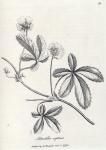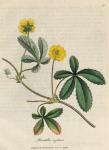059. Potentilla reptans. Common cinquefoil.

 Also see 009. Tormentilla Erecta. Common Tormentil, or Upright Septfoil.
Also see 009. Tormentilla Erecta. Common Tormentil, or Upright Septfoil.
Synonyma. Pentaphyllum. Pharm. Lond.
Quinquefolium majus repens. Bauh. Pin. p. 325.
Quinquefolium vulgare. Gerard. Emac. p. 987.
Pentaphyllum vulgatissimum. Park. Theat. p. 398. Raii. Hist. p. 611. Synop. p. 255. J. Bauh. Hist. p. 397.
Fragara foliis quinatis, serratis, petiolis unifloris, caule reptante. Hal. Stirp. Helv. n. 1118. Withering. Bot. Arrang. p. 534. Curtis Flor. Lond.
Class Icosandria. Ord. Polygynia. Lin. Gen. Plant. 634.
Ess. Gen. Ch. Cal. 10-fidus. Petala 5. Sem. subrotunda, nuda, receptaculo parvo ex succo affixa.
Spec. Char. P. foliis quinatis, caule repente, pedunculis unifloris.
The root is perennial, long, tapering, or fusiform, furnished with but few fibres, internally reddish, and externally of a yellowish brown colour: the stalks are numerous, slender, purplish, smooth, and creeping; the leaves are quinate, or five, placed together, and sometimes seven, of unequal size, elliptical, obtuse, serrated, veined, somewhat hairy, and sitting close to the common footstalk, which is of considerable length, and rises from the stoloniferous joints of the stem: the stipula: stand in pairs, and are composed of three ovalish leaves: the flowers are yellow, and placed singly upon long slender peduncles: the corolla consists of five petals, which are inversely heart-shaped, of a bright yellow colour, and inserted into the calyx by short claws: the calyx is a perianthium of one leaf, divided into ten pointed segments, which are alternately smaller, and frequently turned back: the filaments are about twenty, short, tapering, and inserted at the glandular base of the calyx, and crowned by oblong, flattish, double-celled yellow antherae: the germina are numerous, and form a conical head, supporting short styles, terminated by blunt stigmata: the seeds are numerous, small, and of a brown colour. It flowers from July till September, and is common on meadow banks, and on the sides of roads.
The roots of this plant have a bitterish styptic taste, and give out their astringent matter both to water and spirit. They were used by Hippocrates and Dioscorides, and by the former particularly recommended for the cure of intermittents. [De Morb. l. 2. p. 473. Foës.] And Ray tells us, that the peasantry still employ them with this intention. [Hist. Plant. p. c. See also Senac de recond. febr. interm. nat. p. 185.] The medicinal quality of Cinquefoil is confined to the external or cortical part of the root, and depends merely upon its astringent effects; it has therefore been chiefly prescribed internally in diarrhoeas and other fluxes, and externally in gargles and astringent lotions: but as its efficacy is much inferior to many other plants of this class, the Cinquefoil is now rarely used. In large doles, however, it may be found no bad substitute for some of the other astringents.

